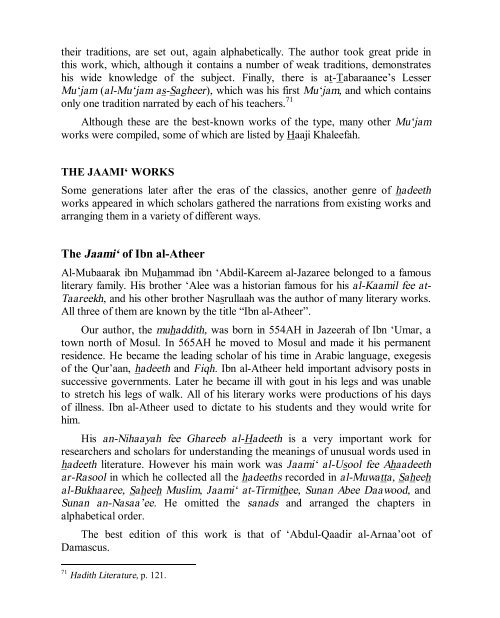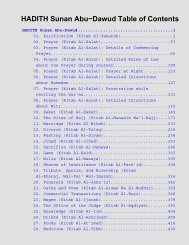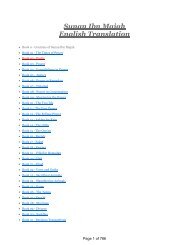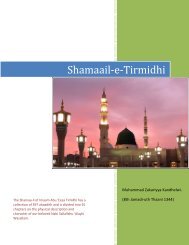Create successful ePaper yourself
Turn your PDF publications into a flip-book with our unique Google optimized e-Paper software.
their traditions, are set out, again <strong>al</strong>phabetic<strong>al</strong>ly. The author took great pride inthis work, which, <strong>al</strong>though it contains a number of weak traditions, demonstrateshis wide knowledge of the subject. Fin<strong>al</strong>ly, there is at-Tabaraanee’s LesserMu‘jam (<strong>al</strong>-Mu‘jam as-Sagheer), which was his first Mu‘jam, and which containsonly one tradition narrated by each of his teachers. 71Although these are the best-known works of the type, many other Mu‘jamworks were compiled, some of which are listed by Haaji Kh<strong>al</strong>eefah.THE JAAMI‘ WORKSSome generations later after the eras of the classics, another genre of hadeethworks appeared in which scholars gathered the narrations from existing works andarranging them in a variety of different ways.The Jaami‘ of Ibn <strong>al</strong>-AtheerAl-Mubaarak ibn Muhammad ibn ‘Abdil-Kareem <strong>al</strong>-Jazaree belonged to a famousliterary family. His brother ‘Alee was a historian famous for his <strong>al</strong>-Kaamil fee at-Taareekh, and his other brother Nasrullaah was the author of many literary works.All three of them are known by the title “Ibn <strong>al</strong>-Atheer”.Our author, the muhaddith, was born in 554AH in Jazeerah of Ibn ‘Umar, atown north of Mosul. In 565AH he moved to Mosul and made it his permanentresidence. He became the leading scholar of his time in Arabic language, exegesisof the Qur’aan, hadeeth and Fiqh. Ibn <strong>al</strong>-Atheer held important advisory posts insuccessive governments. Later he became ill with gout in his legs and was unableto stretch his legs of w<strong>al</strong>k. All of his literary works were productions of his daysof illness. Ibn <strong>al</strong>-Atheer used to dictate to his students and they would write forhim.His an-Nihaayah fee Ghareeb <strong>al</strong>-Hadeeth is a very important work forresearchers and scholars for understanding the meanings of unusu<strong>al</strong> words used inhadeeth literature. However his main work was Jaami‘ <strong>al</strong>-<strong>Usool</strong> fee Ahaadeethar-Rasool in which he collected <strong>al</strong>l the hadeeths recorded in <strong>al</strong>-Muwatta, Saheeh<strong>al</strong>-Bukhaaree, Saheeh Muslim, Jaami‘ at-Tirmithee, Sunan Abee Daawood, andSunan an-Nasaa’ee. He omitted the sanads and arranged the chapters in<strong>al</strong>phabetic<strong>al</strong> order.The best edition of this work is that of ‘Abdul-Qaadir <strong>al</strong>-Arnaa’oot ofDamascus.71 <strong>Hadith</strong> Literature, p. 121.





